Might be old but is news to me.
Lead Hardness Test
Here is a simple way to test the Bhn number of unknown lead samples: all you need is a caliper, two bottle caps, a vise, a 5mm diameter (aprox. size) ball bearing, and a known pure sample of lead (Corbin can furnish pure lead of 99.995% Pb with trace silver).
1. Melt enough lead to fill one bottle cap with unknown sample, and the other with known pure lead. Make sure the surface is smooth and flat when the lead hardens and cools.
2. When the lead is cold, put the ball bearing between the two lead surfaces and squeeze this "sandwich" in the vise until the ball is driven partly into both surfaces (just enough to make a fair sized dent, but not past the middle of the ball).
3. Remove the ball and measure the two dent diameters. First measure the known pure lead dent and write down this number. Then measure the dent diameter in the unknown lead sample and write it down. Square both numbers (multiply times themselves). Then divide the resulting square of the unknown lead dent diameter into the square of the known pure lead dent diameter.
4. The answer should be 1 or greater. If it is a fraction, or less than 1 in value, you have inverted the two dents and divided the wrong way. In that case, try again. When you get an answer that is 1 or greater, multiply it by 5. This is the actual Brinell Hardness Number of the unknown sample.
Here is the formula:
H = 5 * (D1^2)/(D2^2)
Lead Hardness Test
Here is a simple way to test the Bhn number of unknown lead samples: all you need is a caliper, two bottle caps, a vise, a 5mm diameter (aprox. size) ball bearing, and a known pure sample of lead (Corbin can furnish pure lead of 99.995% Pb with trace silver).
1. Melt enough lead to fill one bottle cap with unknown sample, and the other with known pure lead. Make sure the surface is smooth and flat when the lead hardens and cools.
2. When the lead is cold, put the ball bearing between the two lead surfaces and squeeze this "sandwich" in the vise until the ball is driven partly into both surfaces (just enough to make a fair sized dent, but not past the middle of the ball).
3. Remove the ball and measure the two dent diameters. First measure the known pure lead dent and write down this number. Then measure the dent diameter in the unknown lead sample and write it down. Square both numbers (multiply times themselves). Then divide the resulting square of the unknown lead dent diameter into the square of the known pure lead dent diameter.
4. The answer should be 1 or greater. If it is a fraction, or less than 1 in value, you have inverted the two dents and divided the wrong way. In that case, try again. When you get an answer that is 1 or greater, multiply it by 5. This is the actual Brinell Hardness Number of the unknown sample.
Here is the formula:
H = 5 * (D1^2)/(D2^2)

